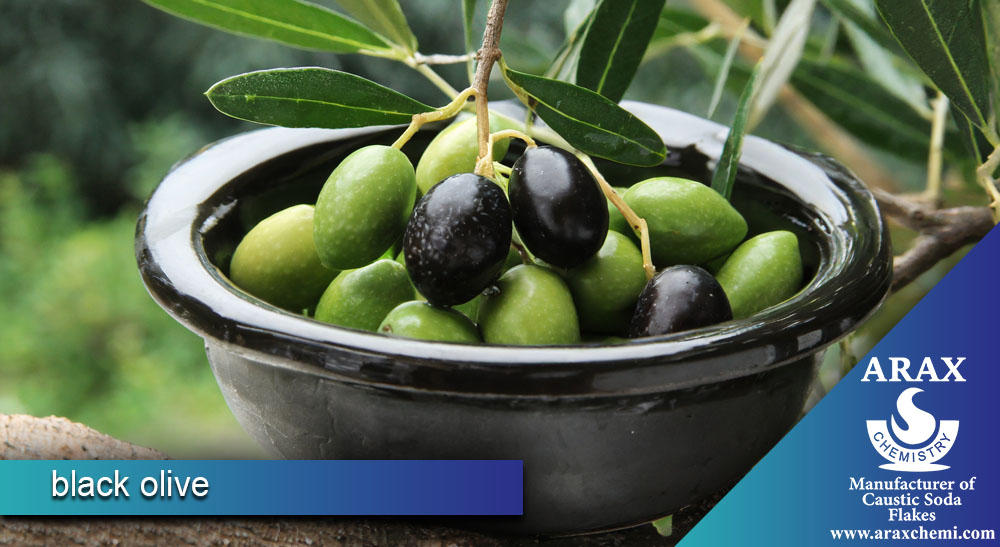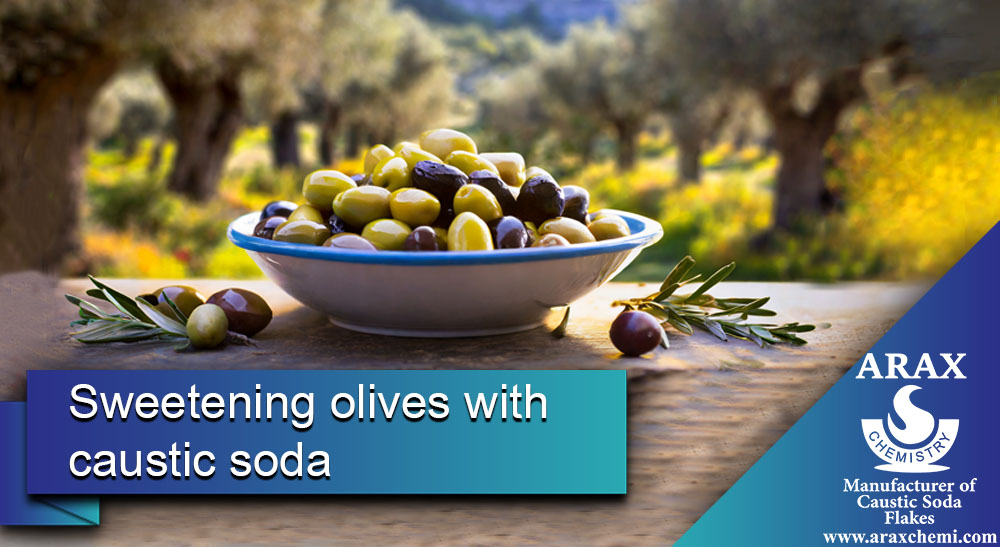Sweetening olives with Caustic Soda
In the past, growing olives has been a common activity in Iran, and in recent years, due to the progress in genetic modification of olive trees and people’s awareness of the properties of this fruit, the interest in planting olives has increased in Iran. This interest is such that people tend to plant this valuable tree in any area where the conditions for olive planting are available. In Iran, from the past until now, many olive trees have been planted in a scattered manner and they have now reached the fruit-bearing stage, and since the collection and sale of the product at this level is not limited by cost, so the owners of the olive trees are willing to find a simple method for processing. the rest of this article, we will examine the types of olives and sweetening olives with caustic soda.
Types of olives
- Green olives
- Yellow olive
- Red olive
- black olive
green olive
There are different types of green olives. Some of the famous types of green and dark olives are:
- Kalmata olive: a dark green olive with a spicy and salty taste that is usually used in preparing Greek dishes.
- Nice olives: dark green to dark black olives with a salty and mild taste, used in salads and French dishes.
- Ascalana olives: a dark green olive with a salty and balanced taste that is used in Italian dishes such as antipasti and pizza.
Each type of olive may differ in its taste and properties, but these are only some of the famous types of green and dark olives.
Yellow olive
There are also different types of yellow or yellowish green olives. In the following, I will explain to you a summary of the characteristics of this type of olives:

- Pisziko olives: This type of olive is originally from the city of Pisziko in Italy. Pishiziko olives are light green to yellowish-white in color and have a sweet and mild taste. These olives are usually used to make olive oil and use in salads, pizza and light foods. (These meals often include light foods such as fresh vegetables, fruits, whole grains, fish, protein-rich chicken, light soups, salads, sandwiches, and foods cooked in low-fat, low-calorie ways.)
- Luscata olives: This type of olive is also from yellowish green to yellowish brown and has a sweet and balanced taste. Luscata olives are commonly used to make olive oil, dried and used in local dishes.
- Granola olive: This type of olive is from light green to yellowish-white and has a salty and mild taste. Granola olives are usually used in the preparation of snacks, salads and light dishes.
- Color and Appearance: Yellow Olive Lytica has a yellowish olive color and may have reddish spots in some places. This type of olive is less sensitive to direct sunlight and its skin is usually thinner and softer.
- Taste: Laitika yellow olives have a sweet and balanced taste. They usually have a meaty and relatively oily texture.
- Usage: Yellow lytica olives are usually used to make high quality olive oil. Also, they can be used in the preparation of salads, pizza, light dishes and snacks as edible olives.
Red olive
Red or pale purple olives are a special variety of olives known as Kalamata olives. In the following, I will explain to you a summary of the characteristics of this type of olive:
- Color and appearance: Calabrina olives have a dark red to pale purple color. Their skin is thin and mottled and oval or oval in shape.
- Taste: Calabrina olives have a salty and spicy taste. They usually have a meaty, fatty and balanced texture.
- Origin and use: Calabrina olive is originally from Greece (Kalamata region). These types of olives are usually used to prepare appetizers, salads, pizza and medium and heavy foods. Also, the Calabrina olive is one of the popular varieties for making high quality olive oil.
black olive
An olive whose skin is black and whose flesh is still completely green is known as an Ascolana olive.

- Color and appearance: Ascalani olives have black skin and fruit flesh that is still completely green. Its skin is relatively thick and porcelain and has an oval or mature shape.
- Taste: Ascalani olives have a salty and spicy taste. Its fruit flesh is relatively green and sour. In some cases, Ascalani olives are used as fresh olives, but mostly as edible olives by stuffing and cooking.
- Origin and use: Ascalani olive is mostly planted in Italy and areas like Riviera Picnarda. This type of olive is usually used to prepare a variety of foods such as stuffed olives, bite-size olives, and cooked olives.
Regardless of the place, time and variety of olives, olives can be separated into the above groups for sweetening and preparing canned salty or sour olives.
In general, in terms of the penetration of the solution into the fruit, as we progress from group one to group eight, the texture of the fruits becomes softer and their permeability increases; Therefore, the percentage of the prepared solution is less and less and the duration of its use is less and less
Sweetening steps of Caustic Soda Olives
After washing the olives and removing the leaves, place the olives in a barrel or non-metallic container.
1) In order to sweeten olives with caustic soda, first, after cleaning and removing foliage and wounded, diseased or infected fruits, put the freshly picked olives into a barrel with any suitable container and add normal water to it; So that after the olives sink, water reaches about 15 cm above the olives.
2) In the second step of sweetening the olives, you should measure the volume of water to determine how many liters of 1.5 liter soda bottles can be used.
3) To sweeten olives with caustic soda, take 20 grams of baking soda for every liter of water and pour the soda into the desired volume of water in a container and stir carefully with a piece of clean wood for a few minutes until the caustic soda dissolves completely. to be
4) with caution and without the solution coming into contact with the hands and skin of the body or its drops harming the eyes; Pour the solution on the olives and close the container. Open the container after 10-12 hours for group 1 olives and 8-10 hours for group 2 olives.
(During this time, it is better to stir the contents of the container several times) The color of the solution has completely turned dark brown.

5) Before pouring the dark colored solution, carefully take out some olive seeds with a tool, rinse them well and put them in cold water for a few minutes. It is sure that the water will not change color. Try the olive seeds with your tongue. If the bitter taste is not felt; Try to pour a dark colored solution, otherwise the olive should still remain in the solution.
6) After you are sure; The olives are de-bittered; Carefully discard the dark colored solution
7) Wash the olives in the container with normal water during 1-2 days by changing the water frequently so that the color of the water does not change.
8) To neutralize the possible residue of caustic soda, add 1 liter of vinegar for every 10 liters of water and after a day and night, change the water in the container 2-3 times.
9) Then drain the olives and keep them in 7% salt water (70 grams of salt per liter of water) for 20-30 hours.
10) Finally, remove the olives from 7% salt water and it is better to use 4% salt water. Boil the salt water and pour it on the olives after cooling, and then transfer the olives to suitable and small containers for consumption or sale. It should be mentioned; Glass containers are preferred for storing olives due to their hygiene.
last word
Olives can be sweetened by using caustic soda. For this purpose, olives were cleaned and placed in caustic soda solution. Then, after 24 to 48 hours, remove the olives from the solution and wash them. Finally, the olives are placed in a salt solution and after 10 days, the sweetened olives are ready to use. With this method, you can make raw olives taste sweeter. Arax Chemical Company is one of the most reliable companies producing caustic soda. Arax Chemical Industrial Group supplies its products with the best quality and competitive price to domestic and foreign markets.

